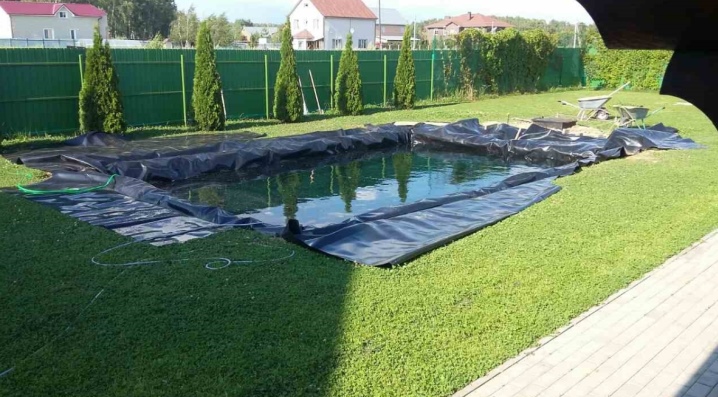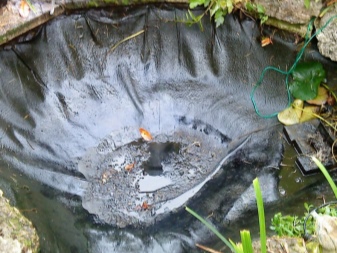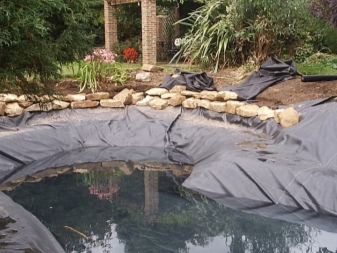What is a pond film and how to choose it?

When arranging an artificial reservoir at a summer cottage, one of the most important stages of work is laying high-quality waterproofing. Most often, different types of film are used for this - they are laid directly on the bottom of the tank or dug out pit. In order to choose the right waterproofing material, you need to know what its varieties exist, as well as get acquainted with their characteristics.
In our review, we will give a description of the main types of film for decorating mini-ponds, dwell on their advantages and disadvantages, and introduce you to a step-by-step guide for arranging a reservoir.

Description
The main purpose of the film when arranging an artificial garden pond is waterproofing. Thanks to the film, water is retained in the pit, thus preventing it from leaking into the ground. In other words, it is a kind of membrane partition that allows you to keep moisture within the boundaries of an artificial pond.
Of course, if you wish, you can use alternative design options, for example, make a cement-concrete base. However, such work will be lengthy and more troublesome and laborious. In addition, you will have to think in advance about the main ways to purify such a reservoir. That is why most of the owners of summer cottages and country cottages stop at using a simple technology for mounting a pond with a film base.

This solution has many advantages:
- the material does not rot under the influence of moisture, does not become moldy and does not create conditions for the reproduction of pathogenic microflora;
- film waterproofing can be installed on a variety of bases and on all types of soil;
- if you wish, you can reorganize the artificial reservoir at any time with little effort;
- using the film, you can always choose the covering pattern you like, which will optimally fit into the landscape design and will increase the decorativeness of the country pond on the site.
Finally, the main thing is that you can always perform any work on the installation of a film reservoir yourself. This does not require professional skills and special tools. The most important thing is to correctly choose the coating in accordance with the technical characteristics of the material.

Varieties
Modern manufacturers offer several different types of film substrates for waterproofing artificial ponds. Each of them has its own technical and operational characteristics, pros and cons. Let's dwell in more detail on the most demanded ones.

Polyethylene
Plastic wrap is considered the cheapest option, but at the same time the most fragile. Manufacturers produce such a coating in rolls with a width of 1.4 m, a film thickness of 0.6-2 mm. In most cases, polyethylene is used to create small country ponds with a simple geometry, since the material has low elasticity. The warranty period varies from manufacturer to manufacturer, but on average does not exceed 3 years.
Polyethylene film has significant advantages:
- affordable price;
- light weight;
- does not give in to decay;
- maintainable.


Of the minuses, they note:
- does not withstand the action of elevated temperatures;
- with prolonged exposure to ultraviolet rays, it loses its original performance;
- when used in an artificial reservoir, it may cause cloudy water;
- has a short operating period.
Experts recommend laying the film in several layers, when buying, it is better to give preference to a coating with a thickness of over 140 microns.

PVC
PVC foil - one of the most common options for arranging a garden pond in a personal plot... The material is produced in rolls 25-50 m long and 2-10 m wide, the thickness of the product is 0.5-1.3 mm.
The stretching parameters of the film reach 200%, the strength under load is 20 kg. The film can withstand pressures up to 2 pascals, 1 sq. m weighs 0.5-1 kg.
To create an artificial reservoir, experts recommend choosing a material consisting of 2 layers with internal reinforcement... The surface of such a film is treated with protective compounds that prevent the appearance of pathogenic microflora on the surface.

The advantages of PVC coating include:
- increased strength;
- tightness;
- resistance to external mechanical stress;
- resistance to temperature fluctuations, while the lower threshold is -50 degrees Celsius;
- good elasticity of the film, which allows you to equip reservoirs of any shape;
- resistance to ultraviolet rays.
Significant savings can be achieved when using PVC film, since it acts both as a waterproofing layer and as a decorative material.


Not without flaws:
- the base of the film is vinyl chloride, that is why it is not recommended to breed fish and plant live plants in such reservoirs - over time, the material begins to emit chlorine, which is most negatively reflected on the flora and fauna of the reservoir;
- you can lay PVC film only on a pre-leveled base.
The warranty period is 10 years, however, with proper care and respect, the service life can be doubled.


Butyl rubber
It is the most durable and practical waterproofing for an artificial pond, it can last at least 50 years.
Butyl rubber film is produced in rolls 50-60 m long and 1.8-15.2 m wide, the film thickness is 1.01-1.15 mm.
The elasticity parameters are at the level of 300-400%, the coating is resistant to mechanical damage - in order to violate its integrity, the action of sharpened fragments of wood or metal will be required. Butyl rubber is not afraid of temperature extremes, retains its physical and operational characteristics in the temperature range from -50 to +120 degrees Celsius, and can withstand short-term heating up to +250 degrees.


The material is very popular among builders and owners of summer cottages. It has a fair amount of pluses:
- not exposed to UV rays;
- due to its resistance to temperature fluctuations for the winter, such a reservoir does not need to be closed;
- completely safe for the environment, when heated, it does not emit toxic substances that can harm animals and plants of an artificial reservoir;
- has increased strength characteristics;
- the film is available in black color - this creates the effect of depth.
It is very easy to install butyl rubber wrap. However, due to its impressive weight, 2-3 assistants are still required. The material is flexible, so it can repeat any, even the most intricate, pond configuration.
Of the shortcomings, only the high cost of such a film.
However, it is fully covered by its durability and practicality.


Decorative waterproofing
Decorative waterproofing with a gravel coating on a film has become very popular. It acts as a decoration - this material allows you to create a spectacular coastline, and in addition, creates a visual effect of the seabed. The gravel is laid out on a film using a special waterproof glue, depending on the model, the stone can have a large or small fraction.


Geotextile base
The material is sold in rolls. It is characterized by a high density of 400 g / sq. m, thickness 4 mm. Such a film is used as a base to ensure the most complete adhesion of the waterproofing layer. Thanks to this, the coating is well preserved during operation.
Tip: To decorate the natural natural appearance of the coastline and for planting plants, you need to additionally purchase coconut mats.


Top manufacturers
Nowadays, there are many companies on the market that are engaged in the production of films for garden ponds. Not all of them offer high quality material. Elite products are produced by enterprises from Germany, as well as from America and Italy. Russian and Japanese companies represent a more budgetary line.


The top 5 manufacturers of waterproofing films include well-known companies.
Polinet
This company is engaged in the production of high quality films for construction and household needs. Products are distinguished by their increased strength, resistance to low temperatures and UV rays. They have high stretching parameters. The service life of the film is 15-20 years.
The waterproofing membranes from this manufacturer are sold in roll form and can be cut in the store depending on how much film the customer requires.


"Anikom"
The company produces HDPE and LDPE geomembranes. It is used to create high-quality waterproofing in garden ponds in personal plots. It is in demand in reservoirs intended for breeding small fish. All products of the company have high tensile strength, do not change their original appearance with use, and are easy to install.

Firestone Building Products
Another manufacturer of waterproofing membranes. It is used for arranging artificial ponds of compact, medium and large sizes. The membrane is extremely durable and elastic at the same time. The film is easy to use, absolutely safe from an environmental point of view. The decorative appearance and pleasant blue color will become a pleasant bonus.
Oase
Popular manufacturer of premium outdoor pool and garden pond equipment. The offered PVB-film can have different thicknesses and a wide range of standard sizes. The manufacturer declares the likelihood of re-using the materials, and at the end of their service life - safe disposal.
The company's products are characterized by waterproofness and wear resistance, easily withstand high and low temperatures. Retains its decorative appearance for a long time.

Ergis
Producer of butyl rubber film. Along with strength and resistance to mechanical damage, this film is resistant to the action of chemical solutions and various impurities in the structure of water. The material has sufficient resistance to loads and temperature fluctuations. The product can withstand sunlight and heat without any problems. The material is elastic, thanks to which such a film can be used to decorate ponds of various, even intricate shapes. The composition does not contain toxic components, so the material can be used in ponds with live fish.
Among Russian waterproofing materials, in addition to Anikom products, preference is given to cheap films from Vinilit.


Selection rules
When choosing a film for arranging a reservoir, it is necessary to take into account not only the decorative features of the material. It is equally important to correctly calculate the waterproofing consumption and take into account some of its operational features.
When calculating the consumption of material, it is imperative to lay some stock. In general, the following formulas should be used:
- film length = the length of the reservoir + 2 depths + allowances of 30-50 cm on each side;
- film width = the width of the reservoir + 2 depths + allowances of 30-50 cm on each side.


With regard to performance, the most important criterion affecting the selection of film thickness is the conditions in which the reservoir will be used. Here you need to consider the following factors:
- the more uneven and bumpy the bottom is, the thicker the film base should be;
- at a depth of an artificial reservoir of less than 1 m, a film with a thickness of 0.5 mm will be enough;
- for reservoirs with a depth of 1-2 m, it is better to take the material with a layer of 1 mm;
- for artificial reservoirs with a depth of more than 2 meters, preference should be given to butyl rubber film.
The choice of the base material can also be influenced by the complexity of the shape of the garden pond, the presence of height jumps, the presence of waterfalls and fountains. In addition, you need to consider in advance whether the pond will be used for breeding live fish or swimming.

Installation features
Any homeowner can create a film-based pond with his own hands - there is absolutely nothing difficult about it. The main thing is to complete all stages of work with utmost care.
If in the process of creating a reservoir you need to connect 2 or more fragments of the coating, then you can use:
- assembly adhesive based on neoprene;
- adhesive composition for PVC film for artificial reservoirs;
- adhesive tape;
- glue-sealant;
- welding machine;
- home iron.


To work you will need:
- film of the required size;
- shovel;
- chainsaw;
- river sand;
- gravel;
- wood cuts for decoration;
- flowers in pots.
First, you need to dig a two-level reservoir, it is better to outline its contours in advance with a hose or any rope.

The work should begin with the design of the top line, the formation of the bottom is done last.
- The banks are tamped with a shovel, the bottom of the pit is covered with a sandy pillow with a layer of 7-10 mm.
- Next, lay out the film in two layers. The coating should lay down without any tension, freely.
- The film is pressed against the shore with large stones. After that, the garden pond is filled with water and left in this form for 1-2 days to check the tightness.
- In order to create the effect of high banks, you can add a low shaft of river sand, tamp it with your hands and cover it with a film.
- Then a shallow groove is dug near the shore, a film is tucked into it and sprinkled with earth / sand or gravel.
- Your reservoir is almost ready - all that remains is to arrange the pond line with tree cuts and fill the bottom of the reservoir with small pebbles.

The following video shows you how to glue the pond liner.













The comment was sent successfully.